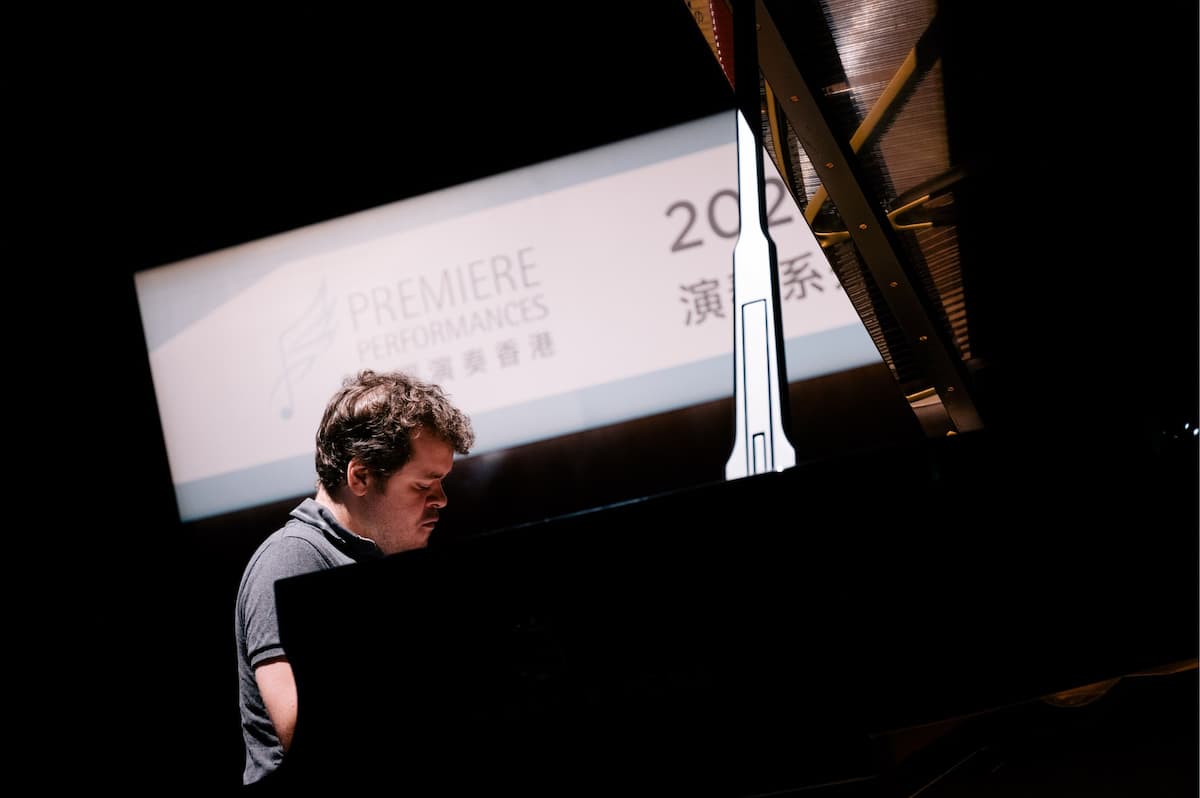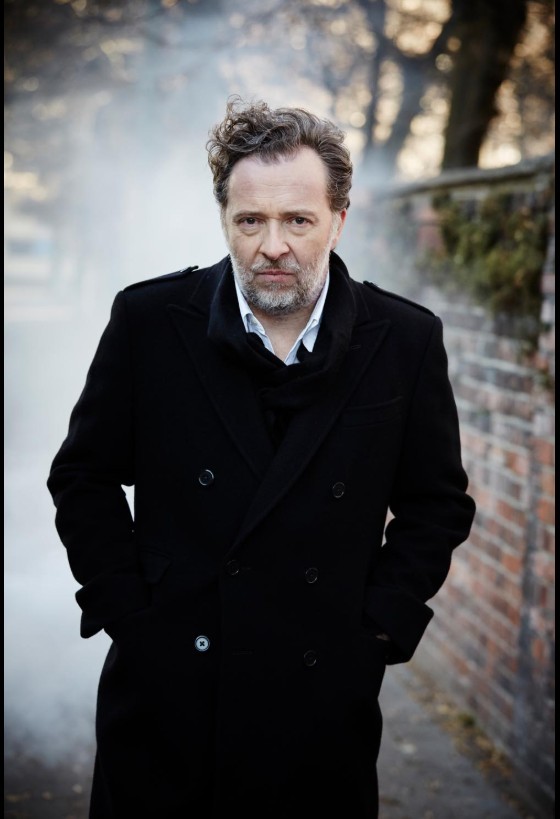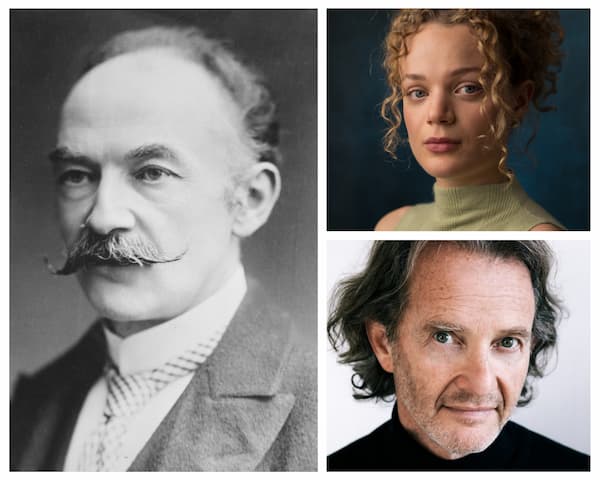Widely acclaimed for his musicianship and technical brilliance, British pianist Benjamin Grosvenor has been on a steady rise in both his career and artistic growth. Following his recital debut in 2015, Grosvenor graced Hong Kong once more after eight years with a thoughtfully curated programme. Liszt’s Piano Sonata in B minor and Chopin’s Piano Sonata No.3 in B minor, arguably the crème de la crème of the Romantic piano repertoire, were showcased, with the inclusion of Chopin’s Barcarolle and Liszt’s Berceuse before each sonata.

Benjamin Grosvenor in rehearsal © Kenny Cheung/Premiere Performances of Hong Kong
As Grosvenor drew back the curtains with Chopin’s alluring Barcarolle in F-sharp major, Op.60, one was drawn in by the tilting motion of a boat evoked by the left hand and the beautiful bel canto approach of the right, soon after the introduction where Grosvenor deliberately sustained the C-sharp octave in the bass with careful pedalling. Apparent technical challenges like ornate decorations and double thirds were transformed into devices that conjured musical imagery. Although the higher register occasionally sounded strained and brittle at forte or louder (likely a limitation of the instrument itself), the dynamics and tonal colours were meticulously layered, exploring the sensual possibilities of the work and suffusing the hall with an almost physical fragrance.
Frédéric Chopin: Barcarolle in F-Sharp Major, Op. 60 (Benjamin Grosvenor, piano)
Notoriously known for its technical difficulty and complexity in formal design, Liszt’s Piano Sonata in B minor was the “real deal” of this recital. It was a journey between hell and heaven through realms of extreme terror, suspense, turbulence, contemplation, and exultation. The performance was both measured and bold – measured in the sense of architecture that was always palpable, bold in his sense of abandon when unleashing the blistering octave passagework with breath-taking speed and intensity. In particular, the build-up towards the climax from bar 376 to 397 was a moment of sheer magnificence and indescribable jubilation, while the Grandioso section in D major possessed such majesty and operatic breadth. Nothing short of refinement either – from the exquisite playing in the cantando expressivo section, to the scintillating runs around bar 239. The diabolical fugato, marked Allegro energico, began with nervous energy, while the Prestissimo section almost reached a state of rapture. His imaginative power and impressive dynamic palette altogether created a narrative depth that is seldom reached in this work.
Franz Liszt: Piano Sonata in B Minor, S178/R21 – Lento assai – Allegro energico – Grandioso – (Benjamin Grosvenor, piano)
Franz Liszt: Piano Sonata in B Minor, S178/R21 – Andante sostenuto – (Benjamin Grosvenor, piano)
An incredible performance, and an incredibly irritating audience as well. Silences are as integral to this Sonata as the notes themselves, frustratingly drowned under a symphony of incessant distractions in the hall – programme notes dropping on the floor repeatedly, phone notifications, unrestrained coughing (even louder than what I normally hear in a medical ward), and even worse, people leaving midway through the performance.
After the intermission was Liszt’s Berceuse, an obvious homage to Chopin’s counterpart, with its decorative flourishes delivered with an enticing touch and nuanced tonal palette.
Franz Liszt: Berceuse, S174/R57b (Benjamin Grosvenor, piano)
The ensuing Chopin Piano Sonata No.3 proved to be equally compelling. The contrapuntal complexity and thematic density of the first movement were rendered with lucidity, accompanied by an expressive cantabile style and natural use of rubato. In the second movement, Scherzo, there was an interesting emphasis on the left hand, while the right executed the passagework with dazzling agility and a leggiero touch. Unfortunately marred by memory lapses in the transition leading back to the A section, the Largo otherwise had warmth and serenity, underscored by subtle voicing and lyrical phrasing. The finale, Presto non tanto, was played with white-hot passion and relentless verve, with the runs sensitively crafted despite the breakneck speed. The dramaturgy of this movement was given its full potential, culminating in a triumphant resolution.
Benjamin Grosvenor Plays Chopin’s Piano Sonata No.3 in B minor, Op.58
In recognition of the roaring applause, Grosvenor graciously returned with a quartet of encores, the first being Ravel’s Jeux d’eau. Translucent and pearly, it painted an evocative tableau of water in various forms, through immaculate layering and a seemingly infinite spectrum of tonal nuances. This was followed by Chopin’s Nocturne in C-sharp minor, Op. Posth. – meditative yet devoid of undue sentimentality. Upon returning to the stage with an iPad and microphone, Grosvenor’s affable greetings prefaced the opening movement of Beethoven’s “Moonlight” Sonata, a whimsical tribute to the Mid-Autumn Festival. The evening drew to a close with Ginastera’s Danzas Argentinas Op.2 No.2, Danza de la moza donosa.
Benjamin Grosvenor Plays Ravel’s Jeux d’eau
Everything in Grosvenor’s music-making is so natural – a poised, aristocratic stage presence, no unnecessary gesticulations or grimaces, and no over-sentimentalisation. With his superlative artistry and imposing pianism, his playing was revelatory in illuminating the music with his own insights and personality, while remaining true to the intentions of the composers. A recital of this calibre, as is its wont, leaves a lasting and thought-provoking echo.
For more of the best in classical music, sign up for our E-Newsletter


